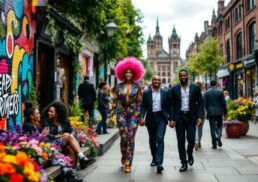Equal marriage, also known as same-sex marriage, refers to the legal recognition of a marriage between two individuals of the same sex. It represents a significant milestone in the fight for LGBTQ+ rights. This article examines the evolution, legal milestones, and social impact of equal marriage.
Table of Contents
Key Takeaways
The early 1990s marked the beginning of significant advocacy for same-sex marriage recognition, influencing subsequent legal and social shifts and setting the stage for future marriage equality advancements.
Landmark Supreme Court cases such as Obergefell v. Hodges and United States v. Windsor played critical roles in establishing nationwide legal recognition of same-sex marriages and striking down discriminatory laws.
Advocacy groups like the Human Rights Campaign (HRC) and shifts in public opinion have been crucial in advancing marriage equality, with legislation such as the Respect for Marriage Act ensuring federal and state-level recognition and protection of same-sex marriages.
The Early Fight for Equal Marriage
The early 1990s marked the beginning of a significant movement to challenge the status quo and advocate for the recognition of same-sex marriages. Activists and legal advocates took bold steps to pave the way for marriage equality. One of the earliest and most notable challenges came in 1993 when the highest court in Hawaii ruled that a ban on same-sex marriage might violate the state’s constitution. This ruling sparked a national conversation and ignited legal battles across the United States, setting the stage for future advancements in same-sex marriage rights.
During this time, several local governments started to acknowledge same-sex relationships. Laws were passed in the District of Columbia and San Francisco, allowing same-sex couples to register as domestic partners and offering them a portion of the rights and benefits usually exclusive to married couples. These early efforts were crucial in laying the groundwork for future legal challenges and societal changes.
The legal and social skirmishes in the 1990s significantly influenced the trajectory of marriage equality. Activists and advocates worked tirelessly to challenge discriminatory laws and raise awareness about the importance of recognizing same-sex marriages. Their efforts set the stage for the landmark rulings and legislative changes that would come in the following decades, ultimately leading to greater acceptance and legal recognition of same-sex couples.
Defining Marriage: A Legal Perspective
Court rulings and legislative acts have significantly impacted the evolving legal definition of marriage over time. Traditionally, marriage was defined as a union between one man and one woman, a definition that excluded same-sex couples and denied them the legal recognition and benefits enjoyed by opposite-sex married couples. However, this traditional definition faced numerous challenges as advocates for marriage equality pushed for a more inclusive understanding of marital unions.
The Defense of Marriage Act (DOMA), passed by the U.S. Congress in 1996, posed a significant challenge to the traditional definition of marriage. DOMA denied federal recognition of same-sex marriages and allowed states to refuse to recognize such marriages performed in other states. Despite this setback, the fight for marriage equality continued, with opponents of DOMA arguing that its definition of marriage was discriminatory and violated the principles of equal protection under the law.
The legal landscape began to shift with the introduction of the Respect for Marriage Act, which declared that all legal marriages, including those granted by marriage licenses, in the United States must be recognized, even across state lines. This act was a significant step towards ensuring that same-sex married couples received the same legal recognition and protection as their opposite-sex counterparts. The evolving legal definitions of marriage have been crucial in advancing the rights of same-sex couples and promoting marriage equality.
Landmark Court Rulings

Marriage equality in the United States has been significantly shaped by landmark Supreme Court rulings. These rulings have not only provided legal recognition for same-sex marriages but have also set binding precedents that continue to shape the legal landscape. The most notable of these rulings is Obergefell v. Hodges, which established same-sex marriage nationwide and required all states to perform and recognize same-sex marriages on the same terms as opposite-sex marriages.
Other significant cases, such as United States v. Windsor and Hollingsworth v. Perry, have also contributed to the advancement of marriage equality. These rulings struck down discriminatory laws and paved the way for further legal recognition and protection of same-sex couples. Together, these landmark court rulings have been instrumental in shaping marriage equality laws and ensuring that same-sex couples receive the same rights and protections as their opposite-sex counterparts.
Obergefell v. Hodges

The landmark case, Obergefell v. Hodges, radically transformed the legal landscape for same-sex couples in the United States. Decided on June 26, 2015, the Supreme Court ruled that the 14th Amendment requires states to recognize same-sex marriages, making it unconstitutional for states to ban such marriages. This historic ruling granted same-sex couples the right to marry in all 50 states, ensuring that their marriages are recognized on the same terms as those of opposite-sex couples.
The case consolidated six lower-court cases, representing multiple same-sex couples and other plaintiffs who challenged state bans on same-sex marriage. Justice Anthony Kennedy authored the majority opinion, emphasizing that marriage is a fundamental right that supports a two-person union, childrearing, and societal stability. The ruling invalidated the Sixth Circuit’s decision, which had previously upheld state bans on same-sex marriage, and marked a significant victory for marriage equality.
The Obergefell v. Hodges decision was not just a legal victory but also a profound affirmation of the dignity and equality of same-sex couples. It underscored the importance of equal protection under the law and reinforced the principle that love and commitment are not confined by gender. This ruling has had a lasting impact on the lives of countless same-sex couples, allowing them to enjoy the same legal rights and protections as their heterosexual counterparts.
Other Pivotal Cases
Beyond Obergefell v. Hodges, other key cases have greatly contributed to the progress of marriage equality. One such case is United States v. Windsor, decided in 2013. This case challenged the Defense of Marriage Act’s (DOMA) definition of marriage as between a man and a woman. The Supreme Court ruled that Section 3 of DOMA was unconstitutional, thereby allowing same-sex couples to receive federal benefits and recognition.
Another important case is Hollingsworth v. Perry, also decided in 2013. This case involved California’s Proposition 8, a ballot initiative that defined marriage as between a man and a woman, effectively banning same-sex marriage. The Supreme Court ruled that the proponents of Proposition 8 did not have standing to appeal a federal district court’s decision that struck down the ban, allowing same-sex marriage to resume in California.
These cases, along with Obergefell v. Hodges, have been instrumental in dismantling discriminatory laws and ensuring that same-sex couples receive equal treatment under the law. They have set important legal precedents and paved the way for further advancements in marriage equality, reinforcing the principle that all individuals, regardless of their sexual orientation, deserve equal protection and recognition.
Legislative Milestones
The legal landscape of same-sex marriage in the United States has been significantly shaped by legislative milestones and federal law. One of the earliest and most significant pieces of legislation was the Defense of Marriage Act (DOMA), passed by Congress in 1996. DOMA denied federal recognition of same-sex marriages and allowed states to refuse to recognize such marriages performed in other states. It was a major setback for marriage equality, but it also galvanized activists to continue their fight for equal rights.
DOMA’s provisions were eventually challenged and ruled unconstitutional by the Supreme Court in two major cases: United States v. Windsor and Obergefell v. Hodges. The Windsor ruling struck down Section 3 of DOMA, which defined marriage for federal purposes as only between a man and a woman. The Obergefell ruling further dismantled DOMA by requiring all states to recognize same-sex marriages, effectively nullifying the act’s discriminatory provisions.
Another significant legislative milestone is the Respect for Marriage Act, which protects marriage rights for LGBTQ+ couples. This act ensures that same-sex couples can marry and have their marriages recognized across state lines, providing them with the same legal protections and benefits as opposite-sex couples. These legislative milestones have been instrumental in advancing marriage equality and ensuring that same-sex couples receive equal treatment under the law.
State-by-State Progress
The journey towards marriage equality in the United States has mostly proceeded on a state-by-state basis, with each state encountering its individual challenges and milestones. Some key milestones in the journey towards marriage equality include:
Massachusetts becoming the first state to legalize same-sex marriage through a court ruling in 2003
The Supreme Court striking down the Defense of Marriage Act (DOMA) in 2013, which allowed for federal recognition of same-sex marriages
The Supreme Court ruling in Obergefell v. Hodges in 2015, which legalized same-sex marriage nationwide
These landmark decisions and events set a precedent and inspired other states to follow suit, gradually expanding marriage equality across the nation.
California’s journey towards marriage equality was marked by significant ups and downs. In 2008, the state achieved marriage equality, only to face a setback with the passage of Proposition 8, which defined marriage as between a man and a woman. The legal battles that ensued eventually led to the Supreme Court’s decision in Hollingsworth v. Perry, allowing same-sex marriage to resume in California.
Other states also made significant strides towards marriage equality by enacting state law. In 2011, New York passed a same-sex marriage law after a significant campaign by advocacy groups. States like:
Maine
Maryland
Minnesota
Washington
saw substantial investments in state ballot initiatives supporting same-sex marriage. These state-level victories were crucial in building momentum towards nationwide marriage equality and demonstrated the power of grassroots advocacy and legal challenges.
The Role of Advocacy Groups
Advocacy groups have led the battle for marriage equality, playing a vital role in the promotion and protection of LGBTQ+ rights. One of the most influential organizations in this movement is the Human Rights Campaign (HRC), the largest LGBTQ political lobbying organization in the United States. HRC has been instrumental in advocating for same-sex marriage and other legal protections for LGBTQ individuals.
HRC’s efforts have included:
Mobilizing clergy through the Religion and Faith Program, launched in 2005, to advocate for LGBTQ rights
Making significant financial contributions to campaigns supporting same-sex marriage, including a $20 million investment in 2012
HRC’s red and pink equal sign logo, symbolizing support for same-sex marriage, went viral on social media in 2013, further raising awareness and garnering support for the cause.
In addition to its advocacy for marriage equality, HRC has worked on various initiatives to protect and expand LGBTQ rights. For example, the Healthcare Equality Index rates hospitals on their policies for LGBTQ patients and employees, ensuring that healthcare providers offer inclusive and equitable care. The tireless work of advocacy groups like HRC has been instrumental in advancing marriage equality and securing legal protections for LGBTQ individuals.
Public Opinion and Social Change
Over the past few decades, public opinion on same-sex marriage has experienced a dramatic shift, mirroring broader social transformations and heightened acceptance of LGBTQ+ rights. In the late 1980s and early 1990s, support for same-sex marriage was relatively low, with a majority of Americans opposing it. However, support steadily increased between 1% and 1.5% per year from 1988 to 2009, and accelerated thereafter.
By 2011, support for same-sex marriage had crossed the 50% mark in Pew Research Center polling for the first time. This shift in public opinion was further evidenced by Gallup polling, which showed a rapid increase in support and a simultaneous decline in opposition. By 2023, a New York Times/Siena poll found that 70% of Americans supported same-sex marriage, highlighting the significant change in societal attitudes.
Support for same-sex marriage is particularly strong among:
younger generations, with near-universal support among 18-34 year olds
women
people with higher education levels
those on the ideological left
Despite this growing acceptance, support for same-sex marriage remains lower in places where more people consider religion important, illustrating the ongoing challenges in achieving universal acceptance, especially in areas that ban same sex marriage.
Global Perspectives on Equal Marriage
Worldwide views on same-sex marriage, influenced by cultural, religious, and legal factors, exhibit a wide range of variation. In countries like Sweden, support for legal same-sex marriage is overwhelming, with 92% of adults in favor. Western European countries such as the Netherlands, Spain, France, and Germany also show high levels of support, exceeding 80% in each case. These nations have been at the forefront of legalizing same-sex marriage and advocating for LGBTQ+ rights.
In contrast, other parts of the world exhibit much lower levels of support. For instance:
In Indonesia, 92% of the population opposes same-sex marriage, with only 5% supporting it.
Similarly, in Kenya, only 9% of adults favor same-sex marriage.
Even in countries where same-sex marriage is legal, such as South Africa, opposition remains significant, with 59% of the population against it.
These figures highlight the ongoing cultural and religious challenges faced by advocates of marriage equality, including those supporting interracial marriages, in many regions.
Despite the disparities, there are promising trends indicating a potential increase in the recognition of same-sex marriages globally. Changing social attitudes, influenced by advocacy efforts and increased visibility of LGBTQ+ individuals, are gradually shifting public opinion. Countries like India, where 53% of adults support same-sex marriage, and Vietnam, with 65% support, exemplify this positive trend, even though same-sex marriage remains illegal in these countries.
Benefits of Recognizing Same-Sex Marriages
The recognition of same-sex marriages yields numerous benefits, not only for the couple but also for society at large. One significant advantage is the access to federal benefits, such as Social Security. Legal recognition allows LGBTQIA+ spouses to claim Social Security benefits based on their spouse’s work history, providing financial security in retirement. Additionally, same-sex married couples can leave unlimited assets to each other without triggering federal estate taxes, ensuring that their loved ones are financially protected.
Tax advantages are another key benefit of recognizing same-sex marriages. Same-sex married couples can take advantage of gifting rules that allow them to split the annual gift tax exclusion amount, effectively doubling their ability to make annual gifts without triggering the gift tax. Moreover, inheriting spouses in same-sex marriages benefit from the elimination of state inheritance taxes. These financial planning opportunities provide significant economic advantages for same-sex couples.
Legal recognition also ensures that same-sex spouses enjoy the same legal protections as opposite-sex couples. This includes property owner survivorship rights, which allow a surviving spouse to automatically inherit property without the need for probate. Same-sex spouses can also own property together as ‘tenancy by the entirety,’ offering protection from creditors and automatic sole ownership upon a spouse’s death. These legal protections are crucial in safeguarding the rights and well-being of same-sex couples.
Learn more, check out One Benefit to Same-Sex Marriage that Nobody is Talking About.
Challenges and Controversies
Despite considerable progress, persistent challenges and controversies surround equal marriage rights. One of the main sources of opposition comes from religious groups, who often cite doctrinal beliefs as the basis for their stance against same-sex marriage. For instance, in 2023, only 30% of white evangelical Protestants opposed religiously based service refusals for LGBTQ people, a slight decrease from previous years. This ongoing opposition reflects the deep-seated cultural and religious beliefs that continue to influence public opinion and policy.
The decline in support for nondiscrimination protections among certain political groups also poses a challenge. For example, support among Republicans for nondiscrimination protections dropped from 66% in 2022 to 59% in 2023. This decline highlights the polarized nature of the debate over LGBTQ+ rights and the need for continued advocacy and education to bridge these divides. The debates often extend to the legal and societal differences between civil unions and marriages for same-sex couples, with some arguing that civil unions do not provide the same level of recognition and protection as marriage.
Moreover, the potential for future legal challenges remains a significant concern. In states where same-sex marriage would remain legal if the Supreme Court’s 2015 decision were overturned, 72% favor allowing gay and lesbian couples to marry legally. However, in states where it would no longer be legal, only 64% support marriage equality. These figures underscore the ongoing need for vigilance and advocacy to protect the hard-won gains in marriage equality and ensure that all same-sex couples can enjoy the same rights and protections, regardless of where they live.
Future Directions for Marriage Equality
The future trajectory of marriage equality is likely to address wider issues of discrimination and advocate for extensive legal protections for LGBTQ+ individuals. Future legislation may aim to:
Eliminate discrimination in various areas, such as employment and housing, ensuring that LGBTQ+ individuals have equal access to opportunities and resources.
Provide legal protections against discrimination based on sexual orientation and gender identity.
Promote inclusive education and healthcare policies that support LGBTQ+ individuals.
Enhance legal recognition and protection for same-sex relationships, including adoption and parenting rights.
Strengthen hate crime laws to protect LGBTQ+ individuals from violence and harassment.
The political climate in different regions and the role of the federal government will play a significant role in how quickly and broadly these protections are implemented.
Continued advocacy and legal challenges will be crucial in advancing marriage equality and related rights. To achieve this, the following actions are necessary:
Advocacy groups, legal organizations, and community leaders need to work together to push for policies that protect LGBTQ+ individuals and promote inclusivity.
Collaborative efforts are essential in overcoming the remaining barriers to full equality.
Ensuring that the rights of same-sex couples are upheld.
As society continues to evolve, it is essential to keep the momentum going and build on the progress made so far. By addressing the challenges and controversies head-on and advocating for comprehensive legal protections, we can create a more inclusive and equitable society for all. The future of marriage equality depends on our collective efforts to promote understanding, acceptance, and justice for LGBTQ+ individuals everywhere.
Summary
The journey towards marriage equality has been long and arduous, marked by significant legal challenges, legislative milestones, and shifting public opinion. From the early efforts in the 1990s to the landmark Supreme Court rulings that established marriage equality nationwide, the fight for same-sex marriage rights has fundamentally transformed the legal and social landscape. Activists, advocacy groups, and countless individuals have worked tirelessly to challenge discriminatory laws and promote equal protection under the law.
Recognizing same-sex marriages provides numerous benefits, including access to federal benefits, tax advantages, and legal protections that ensure the well-being and security of same-sex couples. However, challenges and controversies persist, with ongoing opposition from religious groups and debates over the differences between civil unions and marriages. Despite these obstacles, the progress made so far is a testament to the resilience and determination of those who have fought for marriage equality.
As we look to the future, it is essential to continue advocating for comprehensive legal protections and addressing discrimination against LGBTQ+ individuals. By building on the progress made and working towards a more inclusive and equitable society, we can ensure that the rights and dignity of all individuals are upheld. The journey towards marriage equality is far from over, but with continued effort and commitment, we can create a better future for all.
Frequently Asked Questions
What was the significance of the Obergefell v. Hodges ruling?
The Obergefell v. Hodges ruling in 2015 was significant as it granted same-sex couples the constitutional right to marry in all 50 states, ensuring equality in marriage recognition.
How did the Defense of Marriage Act (DOMA) affect same-sex marriages?
The Defense of Marriage Act (DOMA), passed in 1996, denied federal recognition of same-sex marriages and allowed states to refuse to recognize such marriages performed in other states. It was ruled unconstitutional by the Supreme Court.
Which state was the first to legalize same-sex marriage?
Massachusetts was the first state to legalize same-sex marriage in 2003, setting a precedent for others.
How has public opinion on same-sex marriage changed over time?
Public opinion on same-sex marriage has shifted significantly over time, with the majority of Americans now supporting it. This highlights the change in societal attitudes.
What are some of the benefits of recognizing same-sex marriages?
Recognizing same-sex marriages provides access to federal benefits, tax advantages, and legal protections, such as property owner survivorship rights. It allows for the ability to make hardship withdrawals from retirement accounts for a spouse.









